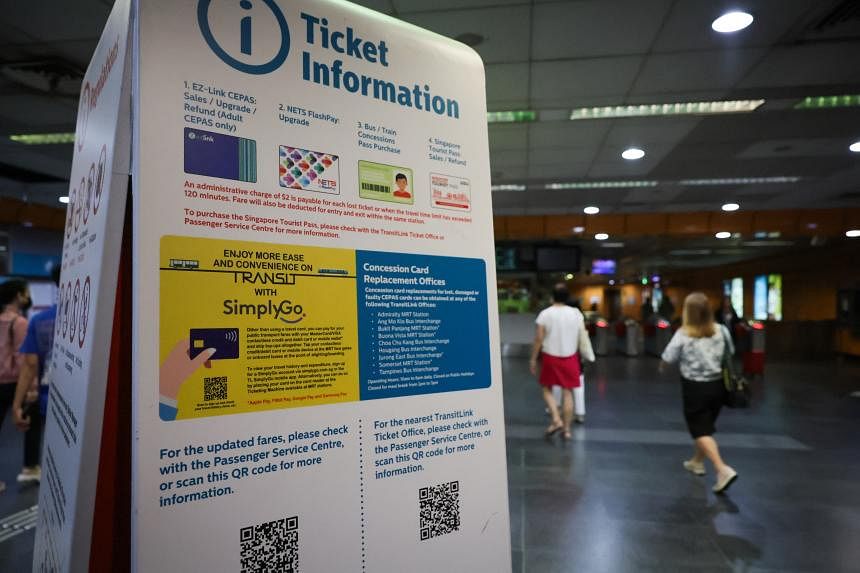SINGAPORE – The controversy surrounding the transition to the SimplyGo payment system received an airing in Parliament on Feb 5, with more than 20 MPs filing questions in a debate that ran for about 40 minutes.
SimplyGo allows passengers to use payment modes such as credit cards and dedicated SimplyGo-compatible ez-link cards to pay for travel on public buses and the MRT.
The Land Transport Authority’s (LTA) plan to make it the only accepted system for adult fare payments from June 1 was shelved after a backlash from passengers.
They complained that with SimplyGo, they cannot see their fare transactions and card balance details immediately when they tap out at fare gates or bus card readers – something that is possible with older ez-link and Nets FlashPay cards, which operate on a card-based ticketing system that stores transaction data on the cards.
Following the public outcry, the decision was shelved on Jan 22, barely two weeks after it was announced on Jan 9. As such, the older ez-link and Nets FlashPay cards can continue to be used.
The authorities will spend an extra $40 million to allow adult commuters to continue using ez-link and Nets FlashPay cards until at least 2030.
Here is a recap of the SimplyGo saga so far:
1. What else did we learn about the SimplyGo system on Feb 5?
Transport Minister Chee Hong Tat has asked LTA to put in more card readers at MRT stations and bus interchanges. Passengers who do not have the SimplyGo app can use the machines to check card balances, given that the information is not shown instantly when tapping out at the end of their journeys.
Mr Chee also disclosed that the lifespan of the card-based system for concession cards will be extended till at least 2030.
The intention is to develop the SimplyGo system, which can now be used for public transport and retail, such that it can be used for motoring expenses, including Electronic Road Pricing and parking charges.
2. How did SimplyGo come about, and what prompted LTA’s earlier decision to switch all adult public transport users to it?
Mr Chee said that in 2016, the LTA wanted to allow passengers to pay for public transport with contactless bank cards and mobile wallets, which were becoming more popular and something that other major public transport systems were starting to offer. A new account-based ticketing system was needed as the existing card-based one does not have this capability.
SimplyGo, an account-based system, was launched in 2019 after a trial in 2017 to allow fare payment by credit cards. Between 2020 and 2023, LTA engaged more than 1,000 commuters – including seniors, adults and students – to gauge their readiness to switch to SimplyGo. They were given the account-based cards to try for a few months.
LTA had said the card-based system for adult commuters would reach the end of its operational lifespan in 2024. To use the system beyond this point would incur spending of an estimated $40 million on hardware, equipment and maintenance, which the agency wanted to avoid. LTA also cited the rising popularity of SimplyGo among adult commuters as a sign that the older system was ready to be retired.
In December 2023, 64 per cent of adult commuters were using SimplyGo. The remaining 36 per cent were using either older ez-link cards or Nets FlashPay cards.
3. What was the fuss about getting on board SimplyGo?
Mr Chee said LTA underestimated the strong preference of some commuters to continue seeing their fare deductions and card balances immediately at fare gates and bus card readers.
When LTA consulted passengers between 2020 and 2023, Mr Chee said, there was some feedback from adult commuters about wanting to see their card balance and fare details, but the authorities “also heard positive comments about the benefits” of SimplyGo.
LTA said earlier that because of the way the account-based system works, where transaction data is stored on back-end servers and not on the cards, such information cannot be shown at fare gates and bus card readers without causing delay to the flow of commuters.
On Feb 5, Mr Chee told MPs in Parliament that LTA is not aware of any technical solutions that can overcome this “latency problem”, and other public transport systems around the world also have this limitation with their account-based systems.
4. Where do Singapore’s public transport fare payment systems stand right now?
There are now three separate systems handling public transport payments in Singapore.
In addition to the account-based SimplyGo system, there are two card-based systems: one for adults and another for concession-card holders.
The $40 million spending goes towards keeping the adult card-based system running.
Mr Chee said on Jan 26 that the decision to extend the system for concession cards was taken earlier. He did not provide the cost of this.
Both card-based systems will remain in use until at least 2030.

5. What is being done right now to improve the payment systems?
LTA has been tasked to find a way for the SimplyGo system to show fares and card balances, said Mr Chee.
The agency will also be figuring out how to integrate the card-based systems for adult and concession fares without affecting commuters and to reduce costs where possible.
In response to a question from Mr Xie Yao Quan (Jurong GRC) on the technical feasibility of integrating the two systems, Mr Chee said: “We currently plan for both the card-based ticketing systems – for adult commuters and also concession-card holders – to run till at least 2030.
“Of course, if we are able to find a good solution before that, we can always make a decision whether to integrate (them) earlier.”


